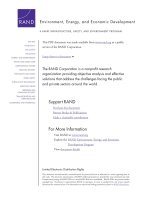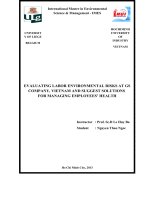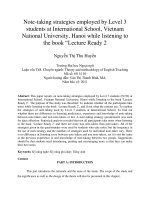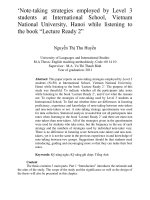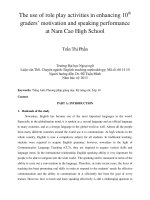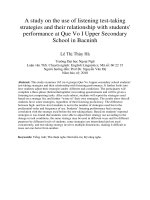improving indirect procurement performance at suntory pepsico vietnam
Bạn đang xem bản rút gọn của tài liệu. Xem và tải ngay bản đầy đủ của tài liệu tại đây (1.19 MB, 36 trang )
HO CHI MINH CITY OPEN UNIVERSITY
UNIVERSITÉ LIBRE DE BRUXELLES
SOLVAY BRUSSELS SCHOOL OF
ECONOMICS & MANAGEMENT
MBQPM5
DO THI DIEU THUONG
IMPROVING INDIRECT PROCUREMENT
PERFORMANCE AT SUNTORY PEPSICO
VIETNAM
MASTER FINAL PROJECT
MASTER IN BUSINESS QUALITY AND PERFORMANCE MANAGEMENT
Ho Chi Minh City
(2016)
STATEMENT OF AUTHENTICATION
I certify that this work "Improving indirect procurement performance at Suntory
PepsiCo Vietnam" is my own work and has not been published in any assessments
before. All materials used in this work has a clear and correct source for
acknowledgement and reference.
Student's confirmation
Do Thi Dieu Thuong
22 April 2016
ACKNOWLEDGEMENT
First of all, I would like to say thank you to SOLVAY BRUSSELS SCHOOL OF
ECONOMICS & MANAGEMENT and HO CHI MINH CITY OPEN UNIVERSITY for
designing and organizing this master course.
I would like to show my deep appreciation for Professor Jacques Martin and all other
Professors for all their care, support and guidance throughout the course for me to
have knowledge and background to complete this report.
I would like to say thank you to all facilitators of both schools to help organize and
arrange our classes during the year.
I also would like to say thank you to all my classmates who are willing to share with
me many helpful experiences and information to enrich my learning.
And last but not least, I deeply appreciate my family for their love, continuous
encouragement and support for me to dedicate time in the study and completing this
work.
Table of Contents
Introduction ............................................................................................................................................. 1
Chapter 1 - Analysis of current procurement performance .................................................................... 2
1.1 Customer satisfaction for Indirect (ID) Procurement service in 2015 ........................................... 2
1.2 SWOT analysis of Indirect (ID) Procurement performance............................................................ 3
1.3 Reasons for unsatisfactory Indirect Procurement performance ................................................... 6
1.4. Strategy mapping on Balanced Scorecard model ......................................................................... 9
Chapter 2 - Design of a performance management system for procurement department .................. 10
2.1 Employee Learning & Growth ...................................................................................................... 10
2.2 Internal Process ............................................................................................................................ 11
2.2.1 Operation .............................................................................................................................. 11
2.2.2 Compliance ............................................................................................................................ 12
2.2.3 Innovation ............................................................................................................................. 12
2.3 Customer ...................................................................................................................................... 13
2.4 Financial perspective .................................................................................................................... 13
Chapter 3 - Challenges of the implementation of performance management system ......................... 14
Chapter 4 - Recommendation for improving Indirect Procurement performance................................ 15
4.1 Capability and collaboration ........................................................................................................ 16
4.2 Process ......................................................................................................................................... 24
4.3 Technology & Innovation ............................................................................................................. 25
Conclusion .............................................................................................................................................. 28
REFERENCES ........................................................................................................................................... 29
LIST OF ABBREVIATIONS
SPVB: Suntory PepsiCo Vietnam Beverage
IP: Indirect Procurement
3PL: Third-party logistics
EDI: Electronic Data Interchange
PR: Purchase request
PO: Purchase Order
KPI: Key performance indicator
SRM: Supplier Relationship Management
P&L: Profit & Loss
HR: Human Resource
OHS: Organization Health Survey
FMCG: Fast moving consumer goods
IT: Information Technology
MNC: Multi-national company
BI: Business Intelligence
CSR: Corporate Social Responsibility
VPO: Volume per outlet
EBIT: Earnings before interest & taxes
PMS: Performance management system
RFQ: Request for Quotation
CPO: Chief Procurement Officer
ERP: Enterprise Resource Planning
BPA: Blanket Purchase Agreement
E-RFI: Electronic-Request for Information
E-RFQ: Electronic-Request for Quotation
E-RFP:Electronic-Request For Proposal
E-RFS: Electronic-Request For Solution
BI: Business Intelligence
LIST OF TABLES
Table 1: Satisfaction with Indirect Procurement Service Quality KPIs
Table 2: Satisfaction with Indirect Procurement Buyer Service Quality KPIs
Table 3: Strategy map in the balanced scorecard model
Table 4 : Procurement’s priorities from study of The Hackett Group (2015)
Table 5: Market Intelligence and access
Table 6: Framework of human resource development
1
Introduction
Company
Suntory PepsiCo Vietnam (SPVB) is a joint venture between Suntory and PepsiCo to
establish a strategic alliance in Vietnam from 2013. Before the joint venture, PepsiCo
had 20 years operating business in Vietnam. Our business is currently focusing on
beverage basing on PepsiCo’s current portfolio and new products from Suntory
brands.
Vision
It is to continue strengthening and maintaining the leading position in Vietnam
beverage industry while continuing to pursue sustainable development objectives,
bringing benefits to our stakeholders, employees and business partners, and
contributing to the communities.
Mission
It is to provide consumers quality, convenient and good-for-health soft drinks. And in
everything we do, we strive for honesty, fairness and integrity.
Strategic objectives:
Become a 1 billion USD revenue company in 2018 with profit at least
from 10%
Offer variety of products to meet customer’s demand with committed
quality by launching 2 new products every year
Ensure 100% products meeting PepsiCo’s global quality standard
Simplify internal processes and increase automation level of all
function’s operations to reduce processing time of all administrative works by
20% by 2017.
Develop next generations of management from local source to take
more than 90% of management positions in the company by 2018.
2
Chapter 1 -Analysis of current procurement performance
1.1 Customer satisfaction for Indirect (ID) Procurement service in 2015
In December 2015, IP took a survey to get internal customer's feedback relating to IP
service quality in 2015. This is the first time IP processed to get customer's feedback
and the result of this survey is summarized in two below tables.
Table 1: Satisfaction with Indirect Procurement Service Quality KPIs
The overall customer satisfaction level for procurement service in 2015 is quite low.
The highest result is just at 42% for the cost criteria, while the lowest result is at 25%
for the lead time criteria of the whole sourcing and procurement process.It shows the
big dissatisfaction from stakeholder for supply lead time. Even for the traditional
criteria - cost, the satisfaction level is also not high.
3
Table 2: Satisfaction with Indirect Procurement Buyer Service Quality KPIs
The satisfaction for buyer service is even lower when the highest score is just at
38%. It shows clearly that there is a problem in IP's buyer capability to fully
understand products/ services being purchased and the market to provide helpful
advice for end-users. The effectiveness of communication and buyer’s response time
is also a hot spot to be improved more.
1.2 SWOT analysis of Indirect (ID) Procurementperformance
Strengths
IP is a big team divided in both function and location. IP has centralized all
indirect activities since October 2014 to handle a big business scale with high
complexity and in urgency environment. With the annual business growth at 20% and
management of an annual spending at 300 million USD with approximate 500
4
suppliers, it requires a lot of buyers' effort to execute and maintain the business
operation smoothly.
Majority of IP team members are young, active and have eager attitude to take
challenge and learn new knowledge. IP has a potential talent pool to bring energy to
this challenging team and IP members are expected to develop capability further not
only to achieve saving targets but also improve service level. Many of IP team
members have technical background which is a great advantage to work along well
with technical team at 5 plants nationwide.
IP has aggressive approach and spent great effort to achieve a saving at least
from 4% and productivity at 2.5 million USD in 2015. IP has supported business to
develop 3PL partners successfully since 2014 which delivered both cost saving
criteria and a professional logistics management. The achievement of logistics
procurement is a bright spot when IP has actually created value for the business by
developing successfully two 3PL partners and in progress of implementing EDI
system to integrate SPVB's warehouse with 2 vendors' warehouse systems to
enhance the technological application and business efficiency.
Weaknesses
One of the hot spots is the low stakeholder's satisfaction due to the long
processing lead time from PR-PO (Purchase request to purchase order). This
weakness has been existing for a long time, and IP is still on the way to improve the
service level.
Buyer's market intelligence is limited. In Direct Procurement, there is a support
from global procurement with internal specialists in charge for each key categories
with high spending and high frequency, like can, sugar, PET bottle/ preform. These
specialists have intensive market intelligence to support for procurement decision
making and utilize their capability of market knowledge to support for business units
of each country. However, it's more difficult to obtain market intelligence for Indirect
Procurement with a large number of categories. Therefore, Indirect Procurement of
SPVB currently receives limited support from regional and global level, which partly
impacts to the information access of supply market, key suppliers and best practice
of cost model and other commercial terms. One of the consideration is lacking
frequent vendor's on-site visits for buyers to understand market and vendor's
capability.
2015 was the year with the highest turn-over rate so far (21%) which shows
the employee's heavy workload and lack of employee's motivation.
5
Management is too focused on daily operation rather than people
development. From my observation, Procurement department in SPVB does not
have a practice to rotate staff within department or across functions. Short
assignments are also not applied popularly in Procurement. This way is limiting the
possibilities for employees to expand their experience in other categories, limiting
talent development and also limiting the possibilities for organization to build future
successors.
Policy and process is currently out of date and complicated, which sometimes
becomes a roadblock for procurement to meet stakeholder's requirements. Process
is one of three backbones of an organization. Therefore, if process is not simplified
and more appropriate, it will prevent the company from its growth trend.
Another issue relating to people perspective is that there was no clear KPI and
performance measurement for IP staff in previous years. When both process and KPI
was not clear, it created confusion for IP staff to identify the right direction for
development.
The low level of automation has been the barrier for efficiency improvement
and that's why IP resource more focused on tackling works than strategic categories
which are opportunities for procurement to add value and bring benefits for the
organization.
Knowledge transferring and supplier relationship management is not focused
and it lacks a system to store data of supplier, transactions, performance, and
communication in each category. Therefore, in 2015 IP suffered a lot when
employees left the company and there were a lot of challenges for new members to
catch up with the current work.
Opportunities
There is a high potential to improve IP's performance in terms of lead time,
cost saving and supplier quality by centralizing purchases with key spending to
manage.
The company's annual growth is 20%, and SPVB's solid brand power in the
market have been creating huge saving opportunities and increasing the our
business attractiveness with suppliers.
The dramatic advance of technology provides tools to increase the control
level and work efficiency while reduce risks and paperwork. SRM, business
intelligence, ERP system, e-sourcing... are all IT solutions procurement can take
advantage of to enhancing its value to the business.
6
SRM system was launched at SPVB since January 2016, but the utilization of
this system at this time is just at tracking email communication and issues during
order’s execution. Uploading documents, data is also a requirement but it’s currently
not complied 100% as expectation. Many other benefits of SRM haven’t been
realized yet to utilize this system for leveraging supplier capabilities, improving
security of supply, enhancing supplier relationship, forecasting on volatile commodity
prices.
Threats
One of the most difficulties for buyers is lacking stakeholder's cooperation in
developing new suppliers to explore opportunities of cost saving and building backup sources to well prepare for the expanding business scale.
The current forecast accuracy is not high, which influence the supplier's price
commitment or delivery time.
The company has grew so fast that system, people, process do not catch up
with and create gaps between the current resources and business expectations.
IP focuses more on sourcing, negotiations to deliver cost saving in P&L report,
but the contract and supplier performance management step is often neglected or
reluctantly processed. Therefore, it is also a gap in risk management and may hold
the company back in its journey to achieve the sustainable growth.
1.3 Reasons for unsatisfactory Indirect Procurement performance
2015 is a very challenging for IP with high turn-over rate. In addition, despite the
huge effort and hard work of IP team, the stakeholder's satisfaction is not as
management's expectation. It made a red flag for HR and management team to have
an analysis to simply understand what was going on in IP team, what were the
obstacles and what was employees’ expectation to do better. The analysis was
conducted through the interview with each employee. The result mostly fell into the
main reason which is the heavy workload in IP. It comes from too many ad-hoc
requests, complicated process and long lead time for approval, ineffective
collaboration with stakeholders, and unsupportive system.
These above reasons can be summarized in three main pillars:
People
Process
System
Firstly, we go through in detail in term of People.
7
Cross-function collaboration:
End-users would like to make decision in the supplier selection as previous.
Therefore, they are unwilling to share their knowledge and information for buyers
and requirements for services sometimes are vague. It will take more time for
buyers to verify back and forth with end users.
Unlike with Direct procurement, Indirect procurement always has to face with
internal conflicts. The key point is how to make internal customers buy in with
Procurement's initiative, help them understand that Procurement is supporting and
adding value to business rather than doing admin works.
In a big corporate like SPVB, it will create more difficulties for buyers to work
effectively in a cross function environment with many complex relations.
Learning and development:
Learning is very important because no one can have knowledge in all categories,
and it is totally correct for IP. IP was established in 2011, but Procurement at that
time just took charge of some main categories in plants, about 10% - 15% of total
indirect spending. IP has step by step been in charge more categories in indirect
spending, like Sales & Marketing, Logistics. In Oct/ 2014, we officially announced
the centralization of all purchasing activities in all categories, but for Marketing, we
mainly take care of spending of below the line activities. For above the line
activities, the involvement of Procurement is still limited due to the nature of work
and other influences from global or regional instructions. Being a young team,
however, IP's scope of works has spread to all activities of business operation. Yet,
one of the shortcomings is the lacking a thorough induction for new hires to
understand Procurement policy, procedures, technical instructions to operate in
system (Oracle PR-PO function). There is no official functional induction for
Procurement new employees, and no instruction for which information need to be
transferred. The current practice is old employees in the team will brief some basic
information relating to Procurement policy, procedure, provide mandatory
templates, instruct manipulations in Oracle. The lack of procedure for a systematic
knowledge transfer from old employees to new employees is really a problem when
no one can control whether information transferred is enough or correct for new
employees to process their work effectively.
Not only for new hire's induction, current Procurement staff also sent feedback that
there is a limit of chance for them to learn both of technical knowledge and
functional skills although there are still some training courses provided by HR. The
employee's expectation is to have more practical courses to be relevant and
applicable to improve the service quality.
Recognition and Reward:
People aspects are complicated and obviously the work quality will be negatively
impacted if people perspectives are not respected. I'm mentioning about recognition
8
and reward. This element should have contributed to the high turn-over rate of IP in
2015. From OHS (Organization Health Survey) report, recognition and reward is
also one of points Procurement needs to improve more to enhance team spirit.
Recognition should be from internal team, and also from external functions which
appreciate Procurement as a supportive function to add value in delivering business
results.
There is a lack of opportunity for internal employees to reach to higher leveland no
clear career road map can be a reason for not getting a long term commitment from
employees.
As the second pillar, Process plays a crucial role in setting the guideline for
employees to follow and being the base for all controlling activities.Process
determines the speed of work flow executed inside the company. As one of the
leading companies in FMCG, the work flow requires faster to be able to react
promptly to the market change or competitor's actions. However, the current
process is too bulky to support business operation to achieve the vision and
strategic objectives. In Procurement part, one of the highlights is the out of date
status of Procurement policy. The latest version was from 2010 while till now, there
have been a lot of changes in both organization structure and scope of works but
policy has not been updated yet.
One of the reasons stakeholders complain Indirect Procurement is the processing
lead time. With a complicated process and long approval lead time, it is obviously
pulling down the efficiency of IP and create more pressure on employees to ensure
the compliance and meeting stakeholder's timeline.
In the third pillar, System nowadays contributes as a key factor to improve efficiency
of business operation. However, comparing with other companies in similar
business scale in FMCG, SPVB has lower automation in business operation. It is
due to the limit of IT investment in previous years. Manual process is limiting the
control ability when our business scale has expanded too quickly in recent years. It
also limit the efficiency of business operation when until May/ 2015, SPVB hadn't
had a online PR-PO for indirect materials. In addition, there is currently no system
for equipment maintenance planning which leads to inaccuracy in spare part
forecast and reduces the equipment operation efficiency. For Procurement, it's
uneasy to access historical data of Indirect spending for analysis and strategy
design. Buyers also have difficulties in supplier performance tracking and evaluation
due to lack of relevant tracking reports from system. Popular tools for e-sourcing
haven't been applied yet; so it takes time consuming for buyers in transactional
purchases and can't focus in strategic categories to add more value for business.
That's why more and more companies have been investing in system to create
9
competitive advantages in a market which is changing so quickly. SPVB is fully
aware of this importance, but the question is how far SPVB can do to replace the
manual process by system.
1.4. Strategy mapping on Balanced Scorecard model
As mentioned in this illustration, Balanced Scorecard model is used to map the
linkage and interdependence of 4 main pillars in business operation to achieve the
main financial objective. In this model, people in Learning & Growth perspective is
the base to connect all activities within the organization and realize internal
processes to maintain three pillars – operation, innovation and compliance. The
outcome is showed through value-added products delivered to internal and external
customers. Customers’ acceptance and cost efficiency is the key for achieving the
strategic objectives.
10
Reduce cost
Financial
Customer
Deliver products
with lower cycle
time
Increase profit &
shareholder's value
Provide addedvalue solutions for
internal & external
customers
Operation
Simplify process
and enhance
empowerment &
authority
Innovation
Evaluate & apply
best-in-class
procurement
practices
Increase revenue
Ensure to deliver
products with
committed quality
Compliance
Follow
government's laws
& regulations
Internal process
Enhance effective
communication
internally &
externally
Learning &
Growth
Attract, retain,
develop talents
Create initiatives
for productivity &
sustainable
development
Leverage technology
for success
Ensure effective
internal control
procedures to be in
place
Develop culture for
learning &
development
Table 3: Strategy map in balanced scorecard model
Source: Modify from Exhibit 1.4 Strategy Map – Page 19 - BALANCED SCORECARD STEP-BY-STEP
(Paul R. Niven)
Chapter 2 - Design of a performance management system for
procurement department
2.1 Employee Learning & Growth
11
Objective
Measurement
Attract suitable talents
Quantity of candidates Quantity
of
suitable
having interest in setting candidates/
total
of
up a career at SPVB
applicants
Strengthen
brand
Develop
competence
KPI
employer Result
of
survey SPVB's
rank
in
"Employer of Choice"
comparison with other
MNCs in FMCG
employee Training courses provided Number
of
training
for employees
courses/ employee/ year
Quality of training courses %
of
per year
processing
reduced
Increase
employee
satisfaction
for
company's
remuneration package
and control environment
Develop an open culture
for
learning
and
development
Procurement
lead
time
Result of Organization % of OHS result increased
Health Survey (OHS)
vs. last year
New ideas proposed in the Number of new ideas/
organization per year
employee/ year
Leverage technology for Automation level of key % of IT projects rolled out,
success
processes
in
each implemented and go live
operation activity
successfully / year
2.2 InternalProcess
2.2.1 Operation
Objective
Measurement
KPI
Simplify
process
to Unnecessary steps are Number
of
process
reduce processing lead removed out of process
simplification
projects
time
successfully applied per
year
12
Have
effectivecommunication
Ensure continuous supply
Ensure right quality
The PR-PO lead time is
shortened or extended due
to effective/ ineffective
communication
On time – in full delivery
Number
of
projects
delayed or issues due to
ineffective communication
Measurement
KPI
Number
of
shipments
delivered on time in full/
Total shipments
Quality is in accepted Number
of
shipments
specification tolerance
passing
quality
control/Total shipments
2.2.2 Compliance
Objective
Risk mitigation (internal & Non-compliance
external)
happen per year
cases The frequency of process
review per year
The frequency of audit per
year
2.2.3 Innovation
Objective
Measurement
KPI
Shorten approval process
The average approval lead
time
from
purchase
recommendation
to
contract/ purchase order
The
annual/
quarterly
evaluation
result
of
supplier performance in all
materials/ services with
spending over 25,000
USD/ year.
% approval lead
reduced vs. before
Apply
business
intelligence (BI) solution
and e-procurement to
improve
procurement
efficiency
time
% of suppliers having
performance improvement
in total of suppliers
evaluated
% of IP transactions from
purchase
request
to
The
number
of
IP purchase order processed
transactions processed on on system in total of
system from purchase company’s
procurement
13
request to purchase order transactions
per year
Create
initiatives
for Number of initiatives per % productivity
productivity & sustainable team and per staff per total spending
development
year
amount/
2.3 Customer
Objective
Measurement
KPI
Improve
stakeholdersatisfaction
for procurement service
level
Increase
Corporate
Social
Responsibility
(CSR) programs
Result of
stakeholder %
of
stakeholder
satisfaction survey
satisfaction rate increased
vs. last year
Ranking in the list of 20 %
of
CSR
program
Companies
having increased vs. last year
remarkable
corporate
social responsibility in
Vietnam
2.4 Financial perspective
Objective
Measurement
KPI
Cost saving
Saving amount achieved % cost saving per year
per
year
(difference (Saving/ Total spending)
between lowest bid vs.
final price)
Productivity
Productivity
amount % productivity per year
achieved
per
year (Productivity/
Total
(difference between last spending)
year’s price vs. final price)
Improve return on cooler VPO after installed cooler
investment
% of VPO increased after
installed cooler vs. before
Profit
% of EBIT in total revenue
per year
EBIT achieved per year
14
Revenue
Gross revenue achieved % of revenue increased
per year
vs. last year
Chapter 3 -Challenges of the implementation of performance
management system
In order to deliver the target outcome, PMS implementation is a crucial stage
deciding the company’s success in achieving its vision & mission through strategic
objectives. During the implementation stage, there will be some challenges which
may delay the progress or even cause the project’s failure.
Fear of risk: This challenge often happens in organization environment which does
not encourage for innovation and continuous improvement. In such case of SPVB,
this challenge may still occur especially for veteran employees with more than 15
working years with company. People tend to have reluctance of changing their
current working method, particularly if they got certain achievements in the past.
However, with SPVB’s significant expansion in business scale in recent years and
annual 20% volume increase, SPVB has no choices but improving itself in terms of
processes, system, employee mindset and capability. It’s just like Dr. W. Edwards
Deming’s quote: “Drive out fear, so that everyone may work effectivelyfor the
company.”(Out ofthe Crisis (MIT Press) – Point 8 of 14).
Overconfidence: In the contrast of fear of risk, a company can have a mistake when
it is overconfident about its resources and capability. If SPVB overlooks the real
business need and does not thorough analyses to understand itself, competitors,
customers and whole market. Without a correct understanding, it can lead the
company to set improper or unrealistic objectives to strive for and achieve. In
addition, the company can be too ambitious and hasty to apply the world class
practices without a serious consideration of the relevance with its current
development status. It will obviously be a waste for the company when the whole
organization is not ready yet and the expected outcome may not achieved.
Unclear communication: SPVB is a big-size company with more than 2,500 official
employees and 2,500 contractors. Therefore, communication can be a challenge in
order for employees from all functions and levels to clearly understand how their work
result contributes to the company’s strategic objectives. It’s very important to get
employees inspired and motivated to endeavor in their work for the whole
organization’s strategic objectives.
Lacking following up the progress and continuous commitment & support from
top management: According to Deming cycle of Plan - Do - Check - Act, the
15
implementation of performance management system is a continuous progress
requiring a high level of self-consciousness to always challenge the current good
things to look for more opportunities of improvement. Without following up, the PMS
implementation will definitely be in failure as no checking leads to no improvement
actions. The following up needs to come from both sides: top down from
management and bottom up from each employee to look through their own works
and raise for management's support to remove all obstacles and close performance
gaps to achieve the organization's objectives.
Lacking collaboration across functions; unclear role and responsibility of each
function: This obviously is a big challenge to manage an effective collaboration
among functions. It's also crucial to define clearly role and responsibility of each
function and in detail for each employee at the very first stage of the project. The
more employees get motivated in their works, the more effectively they can
collaborate, exchange ideas, and work consciously to achieve the common
objectives together.
Chapter 4 - Recommendation for improving Indirect
Procurement performance
In order to improve the performance of any department, the first thing to think about
is people's capability and collaboration to deliver functional objectives and meet
stakeholder's satisfaction. I also make a reference from a study of The Hackett Group
conducted in late of 2014 with participation of executive management and leaders of
finance, HR, IT and procurement of midsized and large companies, which show
some priorities and key focuses Procurement need to improve as showed in the
below table. It's a kind of benchmarking with the world to find common points that IP
at SPVB should improve more.
16
Table 4 : Procurement’s priorities from study of The Hackett Group (2015)
From this study, we can see that while reducing cost is always the key priority as
Procurement's responsibility, other new focuses which are elevating procurement's
role as a trusted advisor and improving procurement's business agility are also
highlighted. Business is requiring procurement to more actively widen business
scope and have an overall business look for the whole organization's benefit. In order
to do that, people perspectives have to be listed on the 1st priority for SPVB to invest
more.
4.1 Capability and collaboration
Beyond the traditional role as supply agent, the new key objective for Procurement to
achieve is becoming a trusted advisor for other functions. It's especially suitable for
IP, where many stakeholders do not know clearly about market, vendors,
procurement process, or even they cannot provide a clear specification but a
conception. Stakeholder's expectation is to receive wise advice or instruction from
Procurement for them to achieve the expected result in while still being compliant
with the company's procurement policy. From the analysis, many stakeholders do not
17
satisfied with procurement's support, and it will be an effort process to change the
way other functions evaluate about Procurement's contribution positively.
Cross function collaboration
In a complex organization like SPVB, collaboration has become a crucial element to
deliver business result. Procurement no longer was a silo function just focusing on
cost saving, but be an integral part of the supply chain from customer demand to
product delivery to customer. So how to collaborate effectively? There are many
ways, in which I myself am interested with the Brittany Wickerson’squote in her article
“Don’t Just Communicate – Collaborate with Stakeholders” (21 August 2014)on the
website (): “It (collaboration) requires us to go from
presenting to engaging; from talking to listening; from hearing to interpreting.”With a
large number of stakeholders across functions, the way IP is doing is just
communication, and even some employees have problem in communication and
make information confused. After improving to have an effective communication, we
need to think about how to engage more with stakeholder’s activities. We can’t stand
by to wait for stakeholders to come and ask for help, but we need to proactively
engage and support them. Procurement should get their whole year planned agenda
at the early of year to define suitable Procurement plan for key categories, and share
with stakeholders to align the approach.
A helpful way to effectively engage with stakeholders is selling Procurement’s value
for stakeholders and asking for the opportunities to coordinate with them at the initial
stage of project. Bringing Procurement’s ideas, market knowledge, process
mastering will help project run smoothly with the consultancy of all relating functions
and build a collaborative environment for the whole team’s success.
Capability
Market intelligence: As Procurement's role has changed from price reducing and
other transactional works to being an advisory agent to add more value for
stakeholders. It requires Procurement to build strong background and market
intelligence for indirect categories.
From the fact at SPVB that Procurement team lacks of guidelines or directions to
process work efficiently in a standard, especially for new members who have
background from other functions like Engineering or Finance. The consequence of
lacking market intelligence is buyers will lose competitive advantage with suppliers
and other competitors, and cannot mitigate supply risk. Getting reference from
Accenture's article "The Market Intelligence Opportunity", I summarize key points
18
which buyers need take into consideration and explore to increase market
intelligence:
Supply market:
- Overall information about the market (PESTEL analysis)
- Key drivers of the market which can impact critically on quality, supply, cost or
future development.
- Porter's 5 forces to understand the buyer position in the market
- Who is the leader in the market and their willingness to our business?
This information can be found publicly through many kinds of communication.
Supplier information:
- Financial situation
- Production capacity (total and spare)
- Capability, especially for professional services
- Past performance
- Market reference
This information can be acquired by supplier interview, supplier's documents, and
historical data of buyer organization, evaluation from their customers, or articles /
research in specific categories. However, buyers need to cross check with various
information sources to ensure the information provided by supplier reflects their
reality.
Commercial information:
- Cost breakdown
- Pricing trend and price forecast
- Average discount of the industry
- Other practices in the market, such as: pricing formula, rebate scheme, how the
cost is charged for customers (cost per case, or cost per kg)
Having an industry's commercial understanding will bring a great advantage and
when combined with market and supplier information, the organization will have
outstanding advantages in negotiation to achieve bigger benefits instead of being
led by suppliers.
Contract information:
